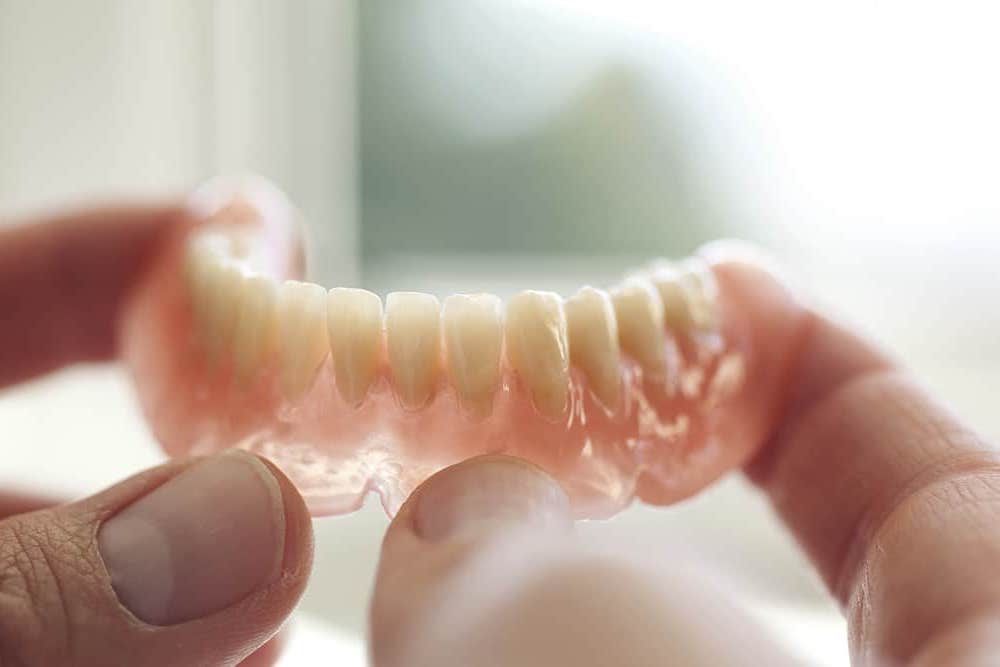
Reasons Bottom Dentures Won’t Stay in and How to Fix Them
When we think of dentures, the vast number of denture wearers report that their upper dentures feel secure. Even though upper dentures work against gravity, they gain suction and adhere to the palate.
Bottom dentures have a reputation for being notoriously loose. You’d think that gravity alone would help keep them in place. But lower dentures don’t have the luxury of adhering to a large surface area of stationary anatomy. They also have to combat a tongue moving up, down, and all around, serving to dislodge them. Lower dentures must rely on a narrow ridge of bone to stay in place. With all of the bottom dentures problems that people experience, how does anyone manage to wear them?
Keep reading to learn about the causes of a loose bottom denture and how to keep bottom dentures in place.
Why Won’t My Bottom Dentures Stay in Place?
A Flat or Negative Ridge
A lower denture will stay in place if you are lucky enough to have adequate bone height and width to support it, especially if the shape of your lower ridge is fairly U-shaped. But if your lower jaw has been without natural teeth for quite some time or you have flat bone, it may be difficult for the denture to be stable since there is so little jawbone for the denture to rest upon.
The Denture Teeth are Not Properly Aligned
The borders and the bite relationships on dentures have a lot to do with why you may have lower dentures problems. In the clear majority of situations, a bottom denture can be made to be stable, comfortable, functional, and beautiful. You may need to use a small amount of denture adhesive for extra security. But you should be able to function with confidence.
Over the years, I have had patients who insist upon having the denture teeth set in front of the ridge in order to make their lips look fuller. Making a compromise like this is totally at the expense of function. You may look like you had a facelift, but you won’t be able to speak or eat without the denture moving. Which is more important?
Impatience
It’s not your fault. No one told you that getting lower dentures was a test to your constitution. Wearing a lower denture requires control from muscles that you’ve never considered before. It is a whole new chapter in your life. As with all transitions, you don’t become an expert overnight. Training the muscles to keep bottom dentures in place takes time, patience, and practice.
The Best Ways to Get Lower Dentures to Stay in Place
Practice, Practice, Practice
Time and patience are required to train the muscles of your face and tongue in order to get used to the denture versus your natural teeth. You’ll need to adjust your eating and speaking habits to accommodate the denture. You will have to chew on both sides of your mouth evenly to avoid placing excessive pressure on one side of the denture. You may also want to try resting your tongue in a different position within the mouth to avoid dislodging the denture.
Denture Adhesives Have Their Place
Denture adhesives may help keep a bottom denture in place. Generally, three small dots will do. More adhesive is not better. No amount of denture adhesive will keep a poorly-shaped or ill-fitting denture in your mouth. If your bottom dentures won’t stay in with a minimal amount of adhesive, it’s time to see a dental professional. If your gums have changed a little, a reline may solve the issue. But if the problem is something else, it may be time to consider new dentures with a more suitable tooth arrangement.
Extra Security
Clearly, the best way to get lower dentures to stay in place is to secure them with dental implants. If you have a reasonable amount of jawbone and are in good health, implant-secured lower dentures are life-changing. Imagine having lower dentures that no longer float or move. And, dental implants help to preserve bone and prevent long-term bone resorption that happens naturally over time.
Find a Fitting Lower Denture Solution at European Denture Center
At European Denture Center, we are the experts when it comes to lower dentures. Over the course of more than 20 years, our denturists and staff have helped thousands of patients who have been labeled “problem patients” by others. European Denture Center will help you face the world with confidence without being hindered or limited by dentures that are not serving you well. We are committed to finding solutions that allow you to live your best life!


